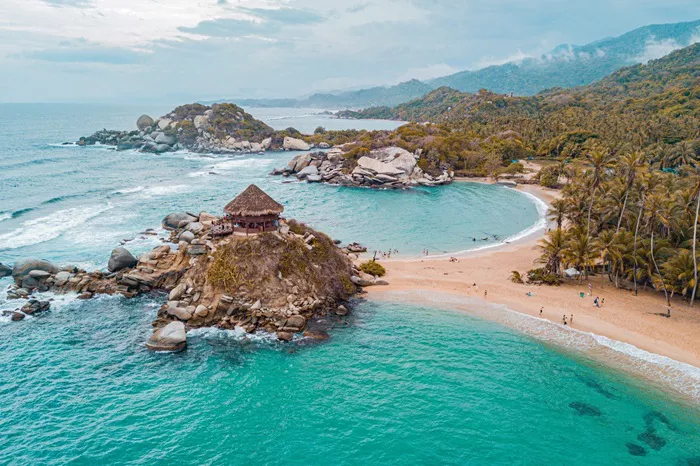Tayrona National Park, officially known as Tayrona National Natural Park, is a protected area located on Colombia’s northern Caribbean coast, within the jurisdiction of Santa Marta. Established in 1964, the park encompasses approximately 150 square kilometers of land and 30 square kilometers of marine area. It is renowned for its rich biodiversity and cultural significance, offering visitors a unique blend of natural beauty and historical heritage.
Natural Beauty and Attractions
Tayrona National Park is celebrated for its stunning landscapes, which include pristine beaches, lush rainforests, and diverse ecosystems. The park’s coastline features a series of idyllic beaches such as Cabo San Juan, La Piscina, and Arrecifes, each offering unique scenery and experiences. Beyond the beaches, the park’s dense jungles are home to a variety of flora and fauna, including over 300 species of birds and numerous mammal species like howler monkeys and jaguars.
The scenic hiking trails that wind through the park provide visitors with breathtaking views of the Sierra Nevada de Santa Marta mountains and the Caribbean Sea.
Activities and Experiences
Visitors to Tayrona National Park can engage in a variety of activities that cater to different interests:
Hiking: The park offers numerous trails that traverse its diverse terrains, leading to secluded beaches and archaeological sites.
Swimming and Snorkeling: Beaches like La Piscina and Cabo San Juan are suitable for swimming and snorkeling, allowing visitors to explore vibrant marine life.
Wildlife Spotting: The park’s rich biodiversity provides ample opportunities for observing exotic birds, mammals, and reptiles in their natural habitats.
Exploring Historical Sites: The park contains archaeological remains of ancient Tayrona civilization settlements, offering insights into the region’s pre-Columbian history.
Visitor Reviews and Ratings
Tayrona National Park consistently receives positive feedback from visitors, who praise its natural beauty and serene environment. However, some reviews note that accessibility can be challenging due to rugged terrain and limited infrastructure. Overall, the park is highly recommended for nature enthusiasts seeking an immersive experience in Colombia’s diverse ecosystems.
Accessibility and Transportation
Reaching Tayrona National Park requires some planning:
By Air: The nearest major airport is Simón Bolívar International Airport in Santa Marta.
By Road: From Santa Marta, travelers can take buses or taxis to the park’s main entrances.
Within the park, transportation is primarily on foot, and the trails may not be suitable for individuals with mobility challenges.
Accommodation Options
Tayrona National Park offers a range of accommodation options to suit different preferences and budgets:
Campsites: Designated camping areas are available for visitors who wish to immerse themselves fully in the natural environment.
Eco-Lodges: Eco-friendly lodges provide comfortable accommodations while minimizing environmental impact.
Hotels: Nearby towns such as Santa Marta offer a variety of hotels for those seeking more conventional lodging options.
It’s advisable to book accommodations in advance, especially during peak seasons, to ensure availability.
Entrance Fees and Costs
As of the latest information, entrance fees for Tayrona National Park are as follows:
Foreign Visitors: Approximately 54,500 COP (Colombian Pesos).
National Visitors: Approximately 16,000 COP.
Additional costs may include camping fees, guided tours, and equipment rentals for activities like snorkeling. It’s recommended to check the official park website or contact local authorities for the most up-to-date pricing.
Best Time to Visit
The ideal time to visit Tayrona National Park depends on personal preferences:
Dry Season (December to March): Offers sunny weather and calmer seas, making it ideal for beach activities.
Wet Season (April to November): Characterized by higher rainfall, leading to lush landscapes and fewer crowds.
Visitors should be aware that the park may close temporarily for maintenance or conservation purposes, so it’s advisable to verify its status before planning a trip.
Tips for a Successful Visit
To enhance your experience at Tayrona National Park, consider the following tips:
What to Pack: Lightweight clothing, comfortable hiking shoes, insect repellent, sunscreen, and sufficient water.
Safety Precautions: Stay on designated trails, be cautious of strong currents at certain beaches, and respect wildlife habitats.
Making the Most of Your Visit: Start hikes early to avoid midday heat, engage local guides for enriched experiences, and practice Leave No Trace principles to preserve the park’s natural beauty.
Conclusion
Tayrona National Park offers a unique blend of natural splendor and cultural heritage, making it a worthwhile destination for travelers seeking an immersive experience in Colombia’s diverse landscapes. While accessibility may present challenges, the park’s pristine beaches, rich biodiversity, and historical significance provide ample rewards for those willing to explore its terrains. Whether you’re an avid hiker, a wildlife enthusiast, or a history buff, Tayrona National Park has something to offer, making it a destination worth considering for your travel itinerary.

